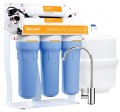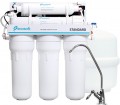Reverse osmosis
The filter has a water purification system based on
reverse osmosis.
Osmosis is the process of transition of water molecules through the so-called semi-permeable membrane — a barrier that freely passes water molecules, but retains substances dissolved in it. Usually this movement occurs from a solution with a lower concentration of impurities to a solution with a higher concentration, but there are ways to run osmosis in the opposite direction. Purification is based on this: pure water passes through the membrane, and impurities dissolved in it remain behind the barrier.
Since the separation is carried out at the molecular level, the degree of purification during reverse osmosis is very high (for example, salt water becomes fresh, not to mention the fact that the membrane does not allow bacteria to pass through). Another advantage of osmotic membranes is a long service life (see "Resource") compared to conventional filter elements: about several years, usually from 1 to 4. At the same time, reverse osmosis systems are also have disadvantages. For example, their normal operation requires a fairly high pressure, and their performance is lower than with most other filtration methods — to the point that you have to install a storage tank, which accordingly affects the dimensions. In addition, unlike other types of filtration, only about 40% of the incoming water is purified with reverse osmosis, while the rest is drained i
...nto the sewer along with the filtered impurities. As a result, this function is found mainly in sink filters and purifiers (see "Type"), where the quality of cleaning is crucial, and large volumes are not required.Pollution clipping
The smallest size of foreign particles (in microns) that the filter can hold in total. Accordingly, the smaller this size, the higher the filtration efficiency, the less undissolved impurities remain in the filtered water. On the other hand, finer cleaning usually takes more time, which affects the speed (throughput) of the filter. It should be noted that in the case of using reverse osmosis filters, the filtration is very fine, up to 0.01 microns.
Tank volume
The capacity of the reverse osmosis tank. The higher the value, the more water can be filtered for future use. Popular sizes include
a 12 L tank and
a 15 L tank. Only in this case the dimensions for installing the filter will become larger. Accordingly, more is not always better. And yes, it affects the price.

